Two men of an older age are seen to be bargaining at a local market – one is selling honey from the back of his van while the second is showing interest in the product. The two most expensive types of honey are the linden and acacia variants: costing around 500 UAH for a 0.5L jar. The cheaper variants cost around 150 UAH for a similar amount of honey. After having a taste of all types of honey and some small talk about global affairs, the client started bargaining for a lower price:
– Let’s do it this way: I’ll take this and this (points to the jar of linden and acacia), but for 350.
– My friend, you can come next year when it will be 350. This year, the season was tough, there is not a lot of honey, so you can take this and this for 400, – says the seller.
This is a typical market in a provincial town. Everything is sold here: going from seeds for sprouting and brooms to smoked meat, which gets prepared in a portable smokehouse. The surroundings seem strange. The market is situated on a square. In the center of the square, one can find the bust of poet Tarash Shevchenko, covered in bullet holes. It became famous due to photos made available by reporters in spring, when the Russians occupied the town for a short period of time. Not far away, a very recognizable building block can be seen (also made famous by photographs circulating from spring), heavily damaged by an aerial bomb. Almost 9 months have passed since the liberation of the Borodyanka in the Kyiv Oblast. Life has been gradually returning to normal, with talks of honey and bargaining and everyday problems becoming more common. However, the war hasn’t gone far away – it has been ingrained in memories and surroundings.
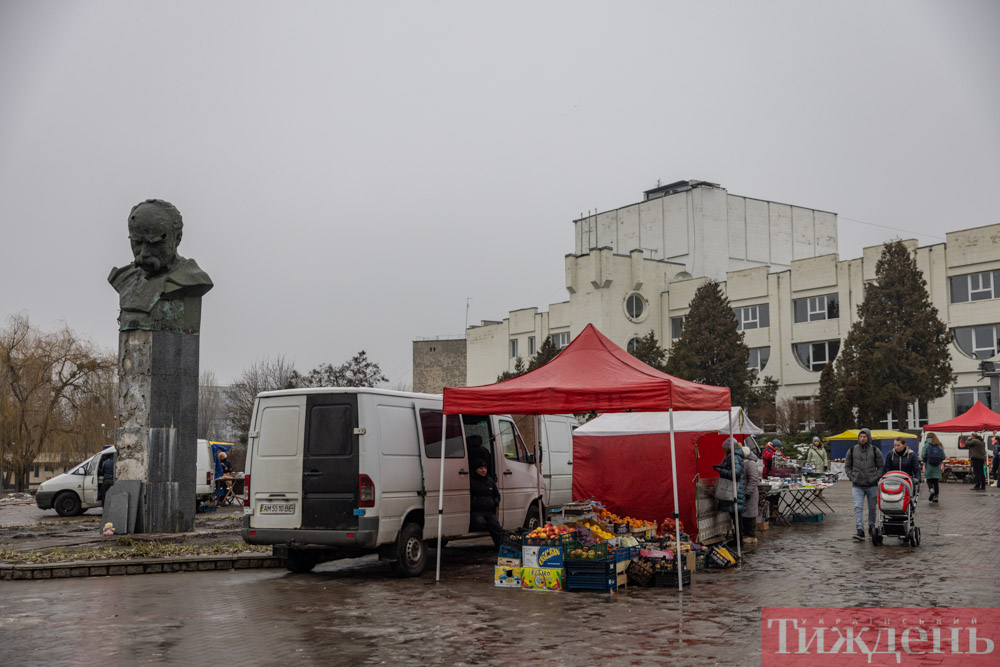
All photos by Stas Kozluk
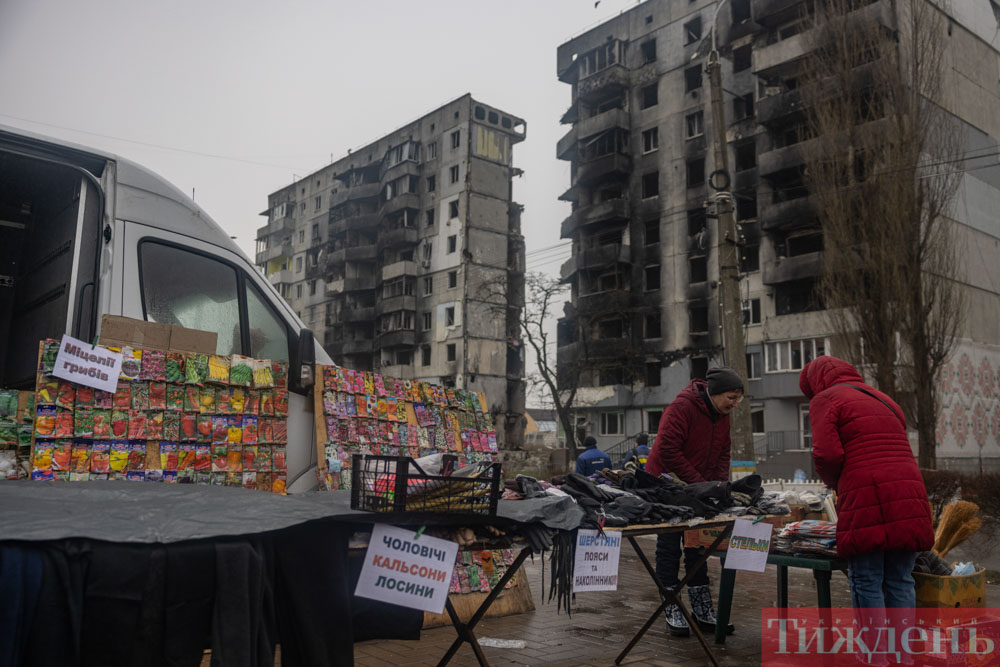
The market, and for the most part, the buildings on the main street of the town carry a very pragmatic name ‘central’. Sometimes, one is able to see the old name of the square: ‘V.I. Lenin’. Looking at the signs and the surrounding rubble, one can recall the pre-war threat by Putin to show Ukraine ‘what real decommunization looks like’.
Next to a building that sits in front of the market (the same block building destroyed by the aerial bomb), two people can be seen conversing. One of them sees us and aggressively reacts to our attempt to join the conversation:
– What, excursions again? Everyone’s driving around here, taking photos of the drawings! This should be banned.

At first, it is unclear what paintings were meant here. However, after seeing the gray concrete, you could see a young female gymnast who was balancing on top of a destroyed wall. One of the seven graffiti left by the world famous artist Banksy, which he created back in autumn. Borodyanka has two of them. The graffiti has caused a stir and prompted many outsiders to take selfies with the artwork. Such artwork helps keep Ukraine in the center of global attention, but it has a different connotation locally.
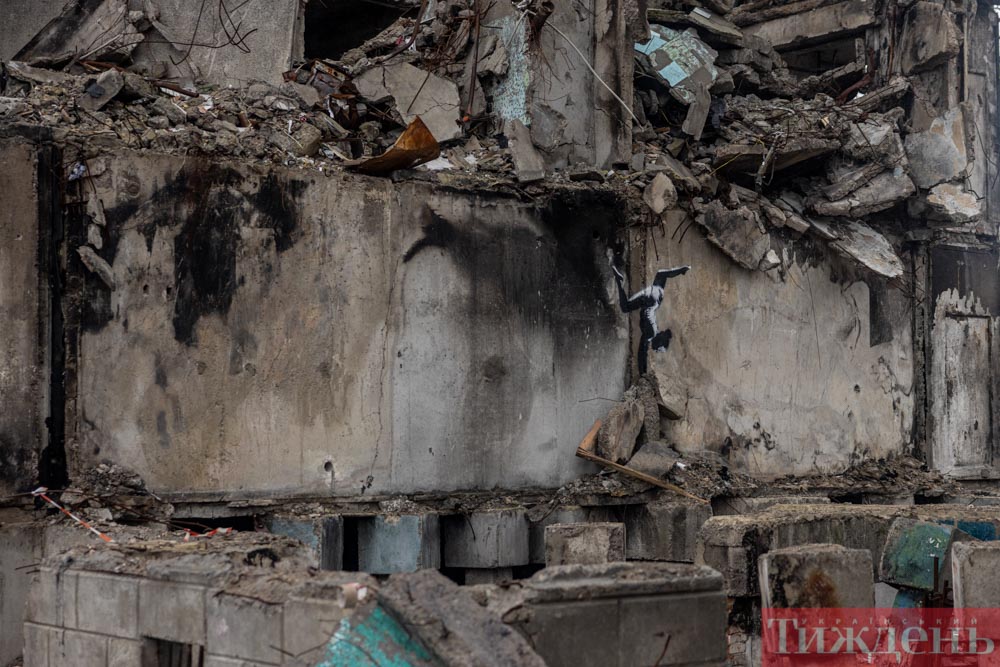
After explaining that we are journalists, the man has somewhat calmed down. The man, Vitaly, considers the graffiti not to be on a canvas, but part of his apartment – or what used to be his home. Vitaly told the story so descriptively that it became easy to imagine a home in place of the rubble and empty space: there was a bath, a toilet, a kitchen and windows would face the other side. His problem with ‘excursions’ are caused by the constant invasions of what used to be his private home. Across town, rumor has it that some elements of the center may be converted into an outdoor museum – leaving some of the damaged buildings as they are. Hence, Vitaly sees the work of Banksy as a threat to the reconstruction of his home or even the provision of a new one.
– They want a museum here but where shall we live? Acts were drawn up, but no one knows what to do next, – he says, angrily.
Vitaly didn’t want to respond directly when we asked whether the local authorities reached out to them. When Tyzhden journalists arrived at the scene, Vitaly was speaking to a man named Valentyn. Valentyn was from a nearby building and was lucky as the building survived, despite receiving serious damage to the plumbing system, and the windows being shattered. Valentyna proceeds to tell us that he received a certain amount of payments from different institutions and funds, including the UN. When asked about other help such as from the government or as a result of the constant visits to Borodyanka of foreigners, he replied:
– Very fortunately, I got to meet the president of Switzerland, – says Valentyn. – During spring, nothing was done, during summer – nothing was done. When the Swiss president arrived, even the windows were replaced and a new heating system was put in place.
The heating system in the building is autonomous. In the area, there was a third building block which was heavily damaged. During our visit, it was already demolished halfway. Just as we were there, the excavators were working. Such activity is very noticeable on the central street.
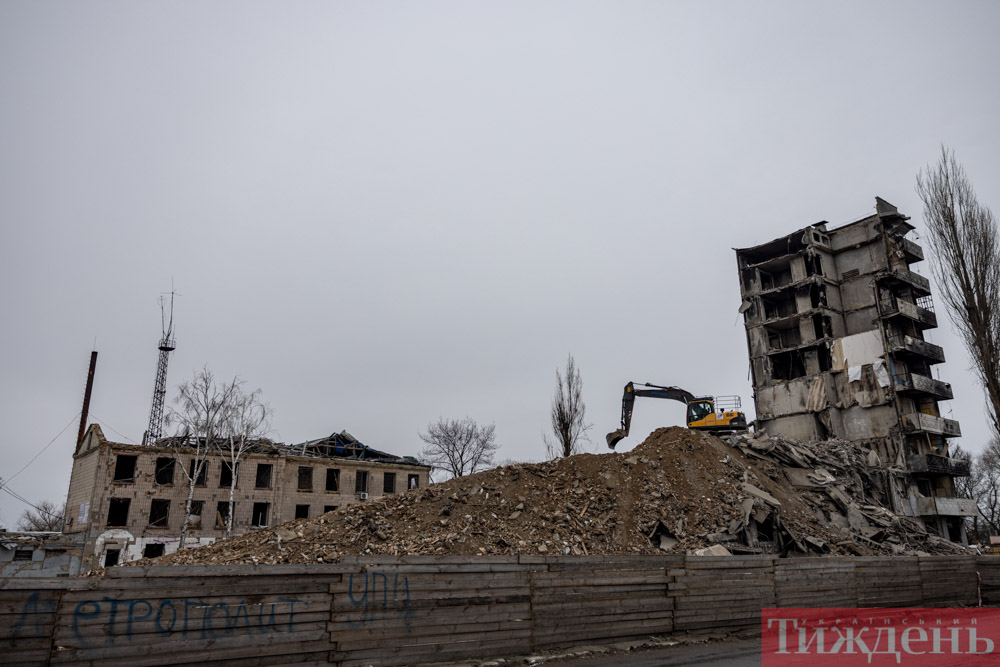
There are a few worker brigades that are in charge of demolishing buildings – buildings that were labeled as inadequate for reconstruction. At the spot of a heavily damaged building of a local military commissariat, one could already find a field of empty space, resembling something like a dug up garden bed.At one of such locations, we got to meet Petro. Petro is a representative of a company that carries out the demolition and watches over the work of the various brigades. At this spot, not much work was left to be done. We stood at the leftovers of what used to be a five-story building. Through the cracks in the concrete, a few rats scatter and run away. Petro continues his story:
– Before the demolition, it is necessary to accumulate granular soil for embankment construction. This is a big chunk of the work, as you must arrange logistics for this. Later, the excavator goes over the embankment and starts to take the building apart from the top. In this manner, the demolition continues all the way to the bottom. Later, one must ship everything out. Big pieces of various constructions are given to the Ukrainian Armed Forces for fortification. The rest, we ship out to an area nearby. It can be later used as subgrade material for road construction.
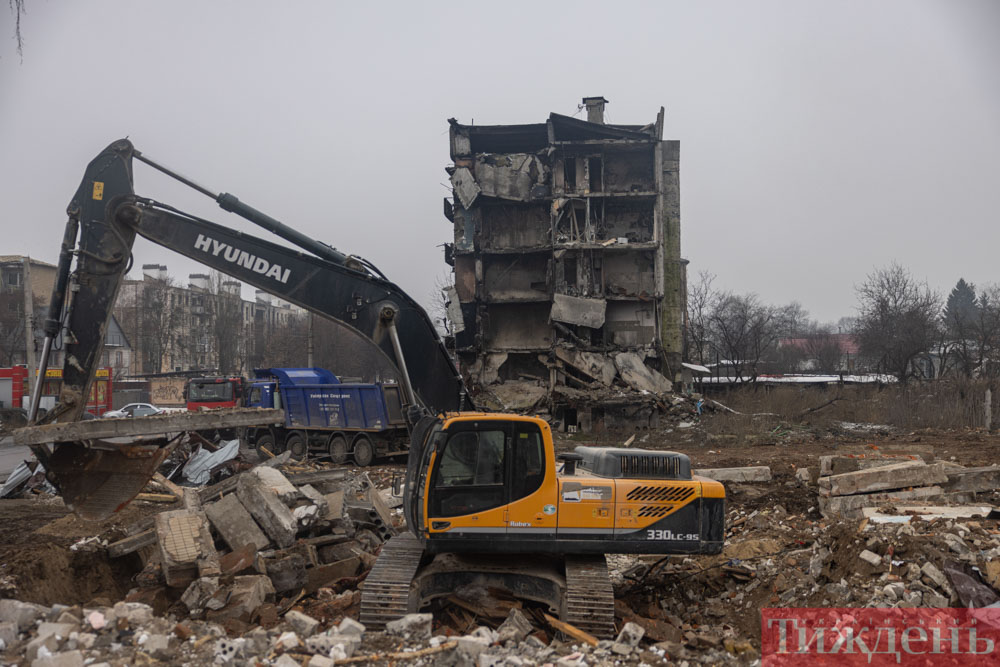
Petro claimed that the site where we were speaking had to be done by the next day (we spoke on the 22nd of December). Things got a little more difficult considering the fact that daylight hours and hence work hours were fairly short in winter. When asked about when the work at the site started, Petro smiled and said:
– On the 1st of December. Talks of this however were already in place in the summer and in the autumn.
Demolition in Borodyanka is being carried out by a Kyiv company called Teravtobud. The relevant information with regards to company tenders can be found on the online platform Prozorro. The work is being paid for from the Kyiv Regional Administration, not from local government entities. To put this in retrospective, the demolition of a single five-story building costs about 5 million UAH (about 120 thousand EUR).
– The building that used to be here – its plates got pushed up through different floors and then kept in place after the explosion. In essence, they shifted, even though the building wasn’t completely destroyed – says Petro. – There are other objects around here that also haven’t been completely destroyed, but experienced ‘spider web’-type cracks in the walls. These are inhabitable. If the concrete has burnt through, the building is also inhabitable. It starts to crumble. However, you would always need the evaluation of special expert groups.
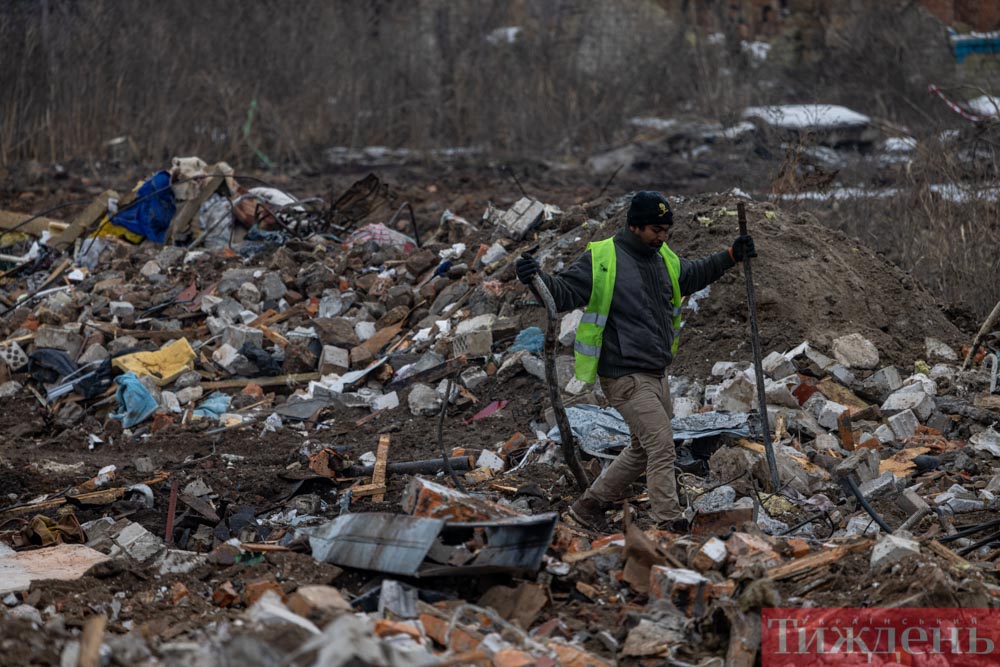
Sometimes, it is difficult to understand why some buildings in central Borodyanka are being demolished while others are being repaired. At some entrances, you can already see notices stating that the building is inhabitable and dangerous to live in, however, you can still go inside and walk upstairs, or even enter apartments if the doors were left open. People would take their valuables out. Some homes do not even look too damaged: some places even had intact linoleum and wallpaper, but the next apartment would have a hole in the floor. In nearby buildings, seemingly just as badly damaged, announcements would say that the expert commissions would be inspecting the damage soon.
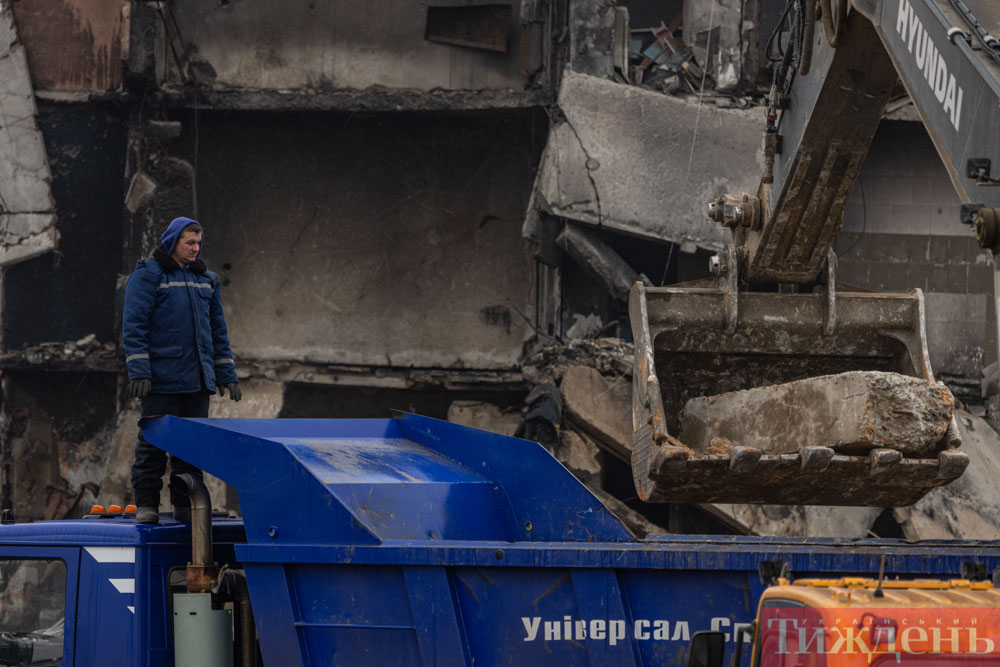
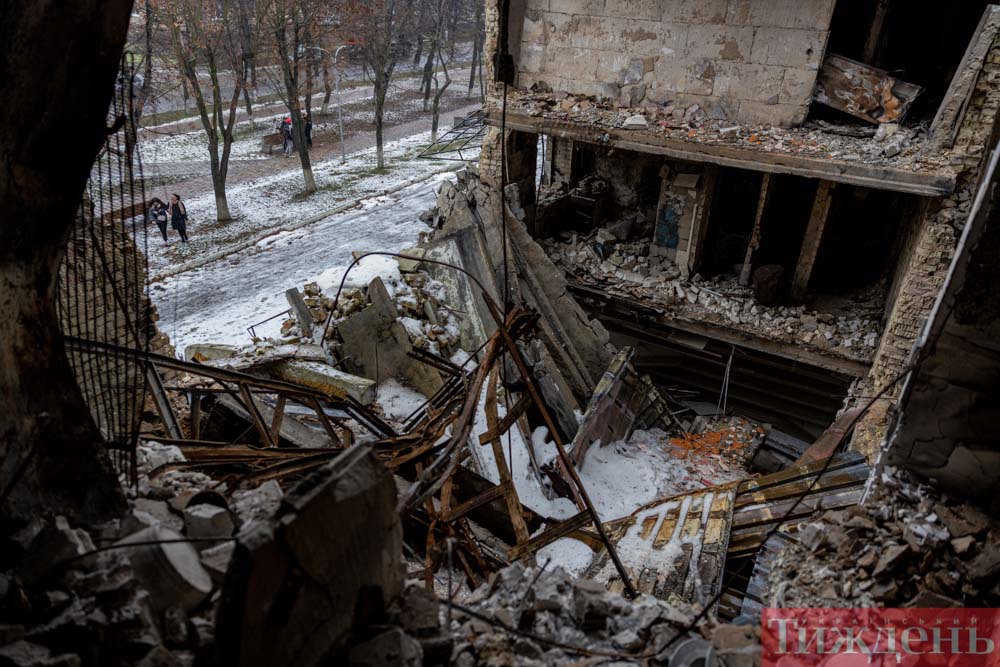
After passing through the central street, we met a woman in one of her front yards, named Yaroslava. She lived in a building that was not going to be demolished, but at the same time, it was not prepared for the winter. Yaroslava’s son lives in a nearby five-story building: and his building was partially settled, despite one of the entrances being completely blown off by an explosion. Next to the ruins, one can find recently brought plastic flowers, in the memory of those who died.
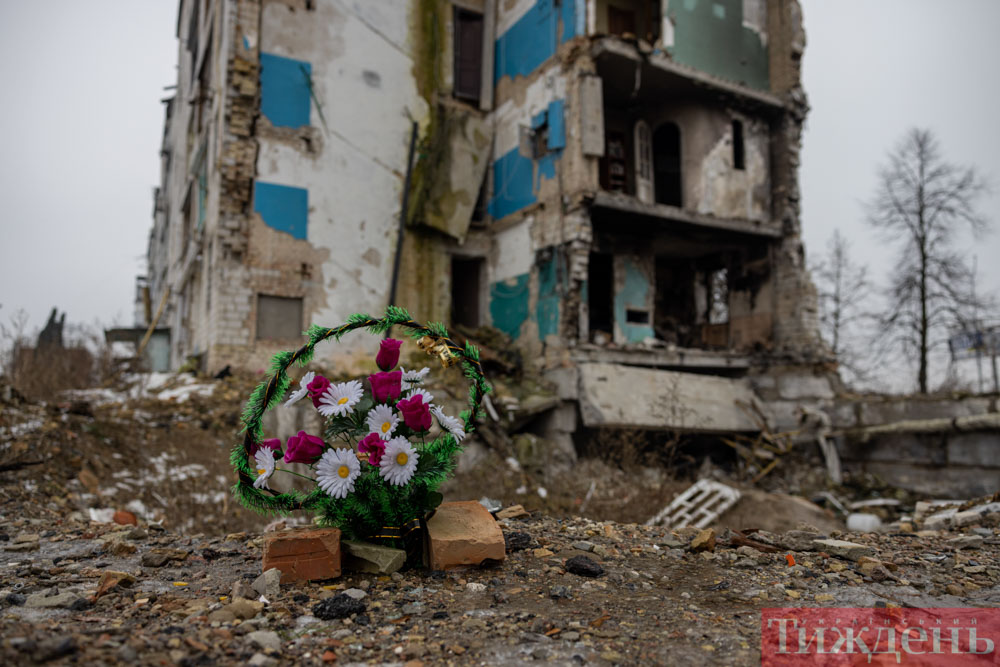
Now, Yaroslava lives with her mother, who lives nearby. She then tells us that in late February, her son called her and told her to hide. She did not listen to him and proceeded to look at the Russian armored vehicles passing through the central street and counting them. She counted 176. The Russians destroyed everything in their path, they brought down a shop with their tank, now replaced by a temporary kiosk.
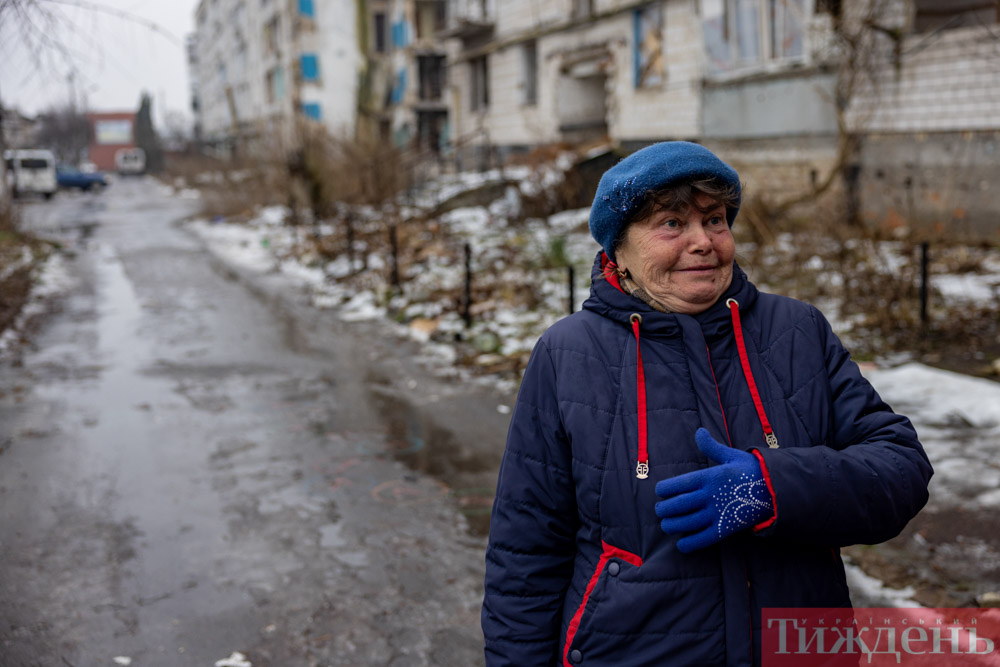
Yaroslava and her family managed to evacuate themselves to Rivne. Everyone was very kind to them, but the man who was volunteering to evacuate them, later died during one of his next missions. He was an evangelist and a father of many children. After the retreat of the Russians from the Kyiv region, Yaroslava’s son was the first in the family to return to Borodyanka.
– I was getting ready to leave in a rush when we left. And I happened to forget jewelry and coins that my son collected. I thought that all of this would have been lost. Then, my son calls me and says that everything is where it was. I was very happy that the jewelry and gold was still there! ‘Mom, the gold is nothing. Luckily, the coins are here!’
As it turned out, one of Yaroslava’s deceased relatives had a huge impact on the way that Yaroslava’s home was saved. He used to collect unique liquor when he traveled to Moscow for work during Soviet times, liquor that had ‘medals on the bottles’ according to Yaroslava. After his passing away, Yaroslava and her family only used the liquor on very special occasions. Later, when the invasion happened, it turned out that Yaroslava’s apartment was broken into after all. However, the invaders did not go further than the liquor collection. Hence, the alcohol with ‘Lenin displayed on the bottle’ saved the gold and the coin collection.
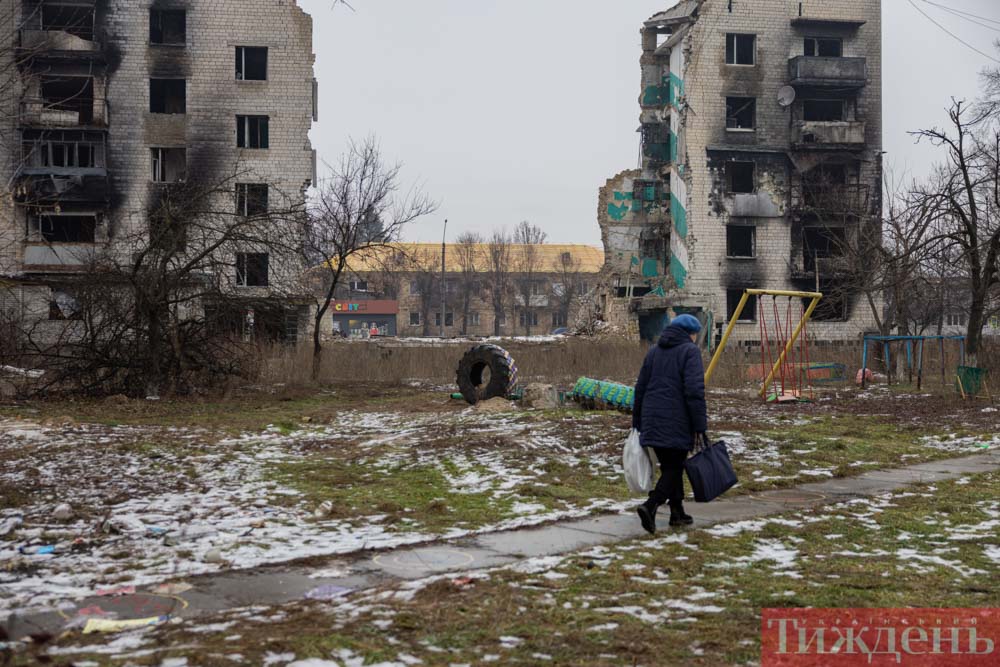
Ms. Yaroslava told us that her son’s building was partially settled by newcomers as a new autonomous heating system was installed. Her flat though, being on the first floor, continues to be cold. Yaroslava wants her building to be renovated.
– Today in the morning, we were called up for an assembly. A commission from Lviv came to inspect the building. In the summer, The Kyiv National University of Construction and Architecture also deployed representatives at the scene which later claimed that the top floor must be demolished as the concrete plates have shifted, while the rest were still salvageable.
At a certain moment, our conversation is interrupted by a young woman with a child who was passing by. She had heard that Yaroslava was from this area and was searching for relatives from the building who she had lost contact with. After a short conversation, she found out that her relatives were all fine. Periodically, people approach another one-story building that is seen nearby, next to the yard of the kindergarten. As we approached the building, it became clear why people were gathering: another one of Banksy’s artworks has been drawn here. This was the second point of the so-called ‘excursion’.
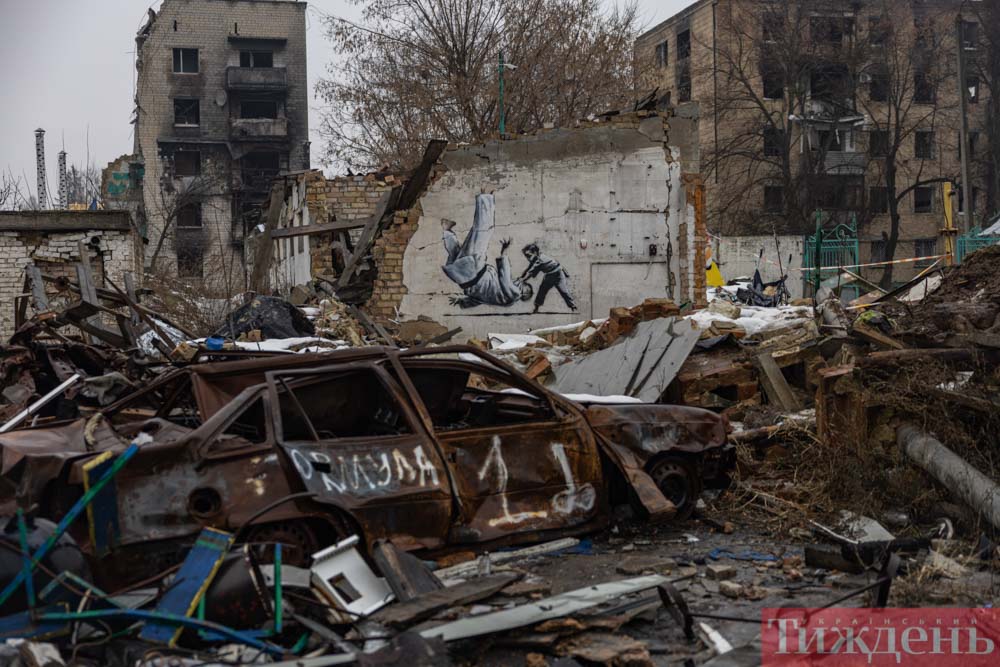
In the opposite direction, we met two men whose business was to ship out the usable parts of demolished buildings. For example, things like interchamber wooden doors and cast iron radiators. After a short conversation with the men, it became clear that some citizens of Borodyanka are distressed about the whole demolition process.
– Orders regarding the demolition were given. However, there were no bilateral agreements that were signed. An apartment gets demolished, but what comes afterwards is unclear. If there was such an agreement that entailed the construction of a new building in place, that would make things totally different.
For the citizens of Borodyanka, there are a few options available. Living with relatives, renting an apartment locally or moving to another location. From what we have heard, the cost of monthly rent in Borodyanka is around 3500 UAH (90 EUR), excluding utility bills. Not as expensive as Kyiv but certainly not cheap by overall Ukrainian standards. Besides the above mentioned options, there is also a modular town which was built in Borodyanka with the help of the Polish government. We proceeded to see what it was like.
The modular town was a set of house blocks situated next to the main football sports complex of Borodyanka. Currently, there are four big blocks, but the city is set to be expanded. Not far away, there seems to be free space for new settlers, according to the commandant of the modular town Olha Kobzar.
– There are 352 living places and there are 260 people here currently. This is due to the fact that we try to admit families together. If a family is made up of three people and the module is meant for four, then we are unable to admit an outsider into that module. However, strangers moving in with others has been known to occur, if the family doesn’t mind, of course.
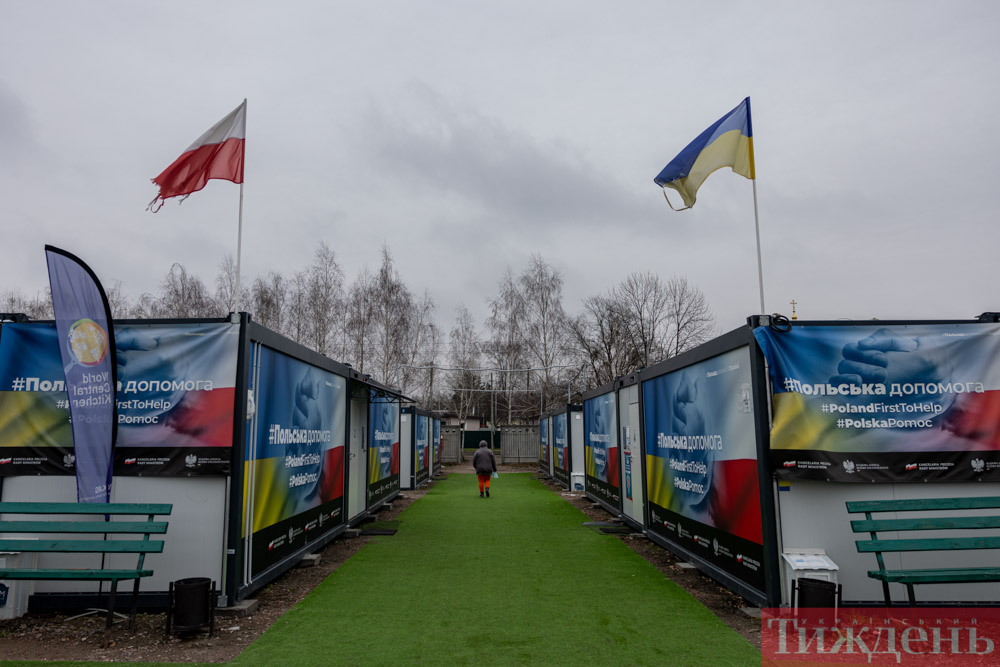
According to Kobzar, the queue for admission to new homes is very long. There is not enough housing even for those who want to rent. In order to be admitted into a new home, one must bring a special certificate that attests that one’s home was destroyed, to a local council. New living space can be given both in the modular town as well as various dormitories. The residence at this point is free of charge. According to Kobzar, the inhabitants of the modular town rarely change. Most of them simply cannot find other places with better living conditions.
Besides the pride felt for their hometown, the various local connections in the community, there is another more practical aspect as to why the people of Borodyanka do not wish to move to other towns and villages. Pavlo, one of the residents of the modular town, explains this to us. He lives in Borodyanka but works in Kyiv, in the metro.
The road from Borodyanka to Kyiv takes about an hour. This isn’t that long considering that some Kyivans take an hour to reach work from their respective neighborhoods further from the center. Wages in Kyiv are higher. According to Pavlo, he earns 15000 UAH (370 EUR) per month, which is not a high wage, but in Borodyanka, he would be able to earn only 8000 UAH (200 EUR). Pavlo tells us that the regional government offered the inhabitants of Borodyanka who lost their homes new homes in Bohuslav. The town is also in the Kyiv oblast, similar in size to Borodyanka. However, it is twice as far from Kyiv as Borodyanka, so one could forget about having Kyiv-standard salaries. Furthermore, settling in such a town would imply more difficulties in finding employment.
A similar proposal was put forward – the city of Boryspil, a city close to Kyiv and also the city with the largest international airport of Ukraine (and more people willing to move there). However, social housing there is scarce. The residents of the modular town tell us that there was a family that managed to find a flat there. However, it was a family with multiple children, so those who are given absolute priority in this regard. However, even they had to pay extra.
– Why can’t they move people into hotels? I used to work for hotel security in Kyiv. The hotel was usually half-full at best. Now, this makes even more sense, – says Pavlo. Soon, Pavlo’s story was confirmed by the interim council chairman of Borodyanka, Heorhiy Yerko. The temporary office of the council is the academic lyceum, which only received light damage from combat and during the occupation. The educational purposes of the lyceum and the needs of the council are being addressed simultaneously here: both attending to their duties on the opposite sides of the building. According to Yerko, people were offered new homes in Bohuslav and in Makariv. At this point, there was no one willing to move there. Now, the in-demand locations were Boryspil and Brovary (and another small town right near Kyiv): the demand for these is very high.
The interim head of the council proclaimed that there were 11 high-rises (711 apartments) and 358 private houses that were completely destroyed. Moreover, 370 private homes need a complete overhaul.
– This is the status as of today. However, due to rain and then below zero temperatures, the numbers can go up, and we’re already seeing this happening – says Yerko.
According to him, the majority of the inspections took place in May-July. However, a certain number of buildings need additional and more thorough inspections in order for a final decision to take place: – Next to the building, there were two-three aerial bombs that exploded, each weighing approximately 250kg, for example. With the use of tools, it is necessary to inspect the foundation and assess the capability of the walls. With regards to buildings that caught fire, it is important to understand the properties of precast concrete blocks. This takes a lot of resources and time. Firstly, the demolition of the buildings that threaten the population takes place. When asked by our new friend Vitaly about the future of the building with Banksy’s work, Yerko responded:
– A decision is to be made as to when and how the graffiti will be moved. The building itself will be demolished. People want to live in the exact same locations as before, and we have attended to their needs. Sometimes, rumors go around about this and that, but they are usually false. Once a decision is made on paper, then we’ll know what will happen.
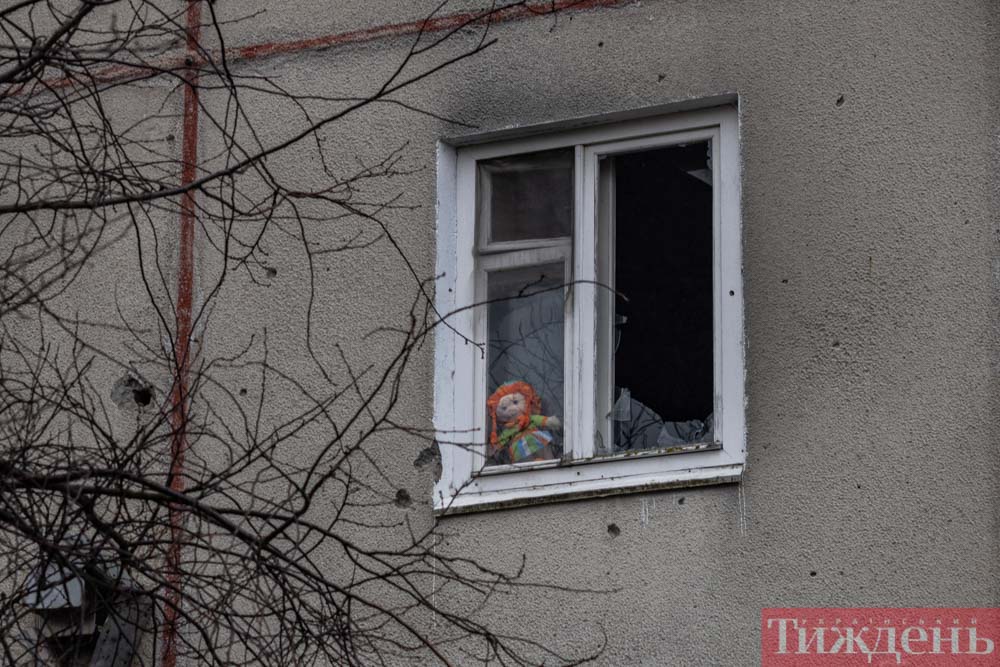
Currently, according to the council chairman, Borodyanka will receive a new plan of a reconstruction of the central street. The project will be brought to the public’s attention with the aim of receiving feedback and any subsequent amendments to then later form a final plan. However, the community council of Borodyanka does not only cover the town, but also a number of surrounding villages. Some of them have been almost completely destroyed. Moreover, many local businesses were forced to close, thus leading to job losses. Some of them have resumed business to a certain degree, such as the local sawmills. For the time being however, the main source of employment happens to be the communal services industry.
Now, everything depends on the external aid received from the regional and central governments, funds and nation states. Even the main communal state-owned company, according to Yerko, has a budget deficit of 6 million UAH. Meanwhile, there are around 700 apartments in town that pay for utilities but use less resources. Nevertheless, it is impossible to decrease the output of the machinery, hence the massive inefficiency.
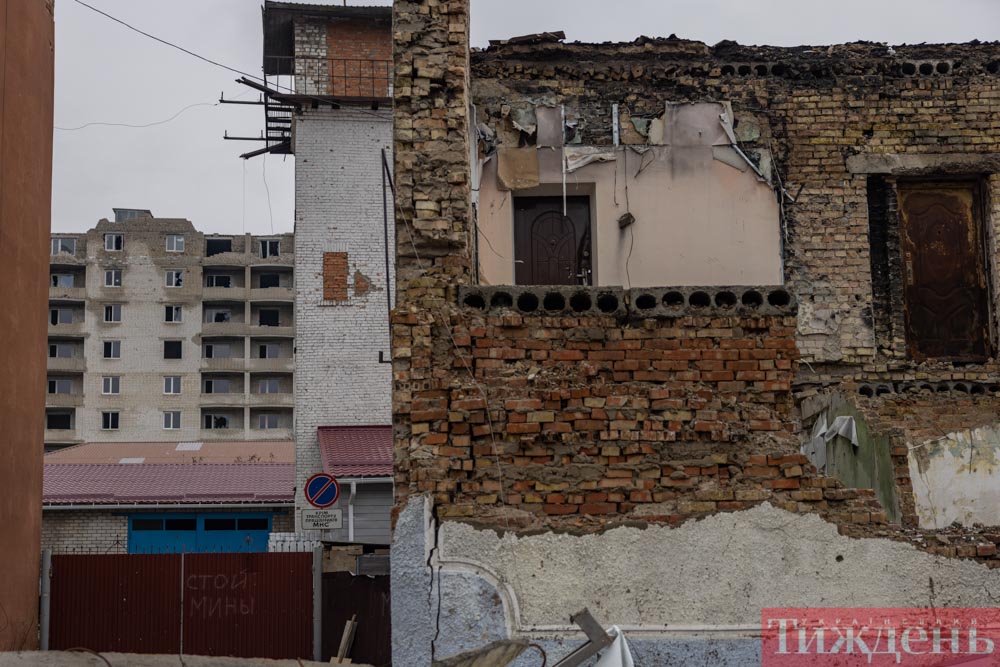
At the start of the war, an idea in the Presidential Office came about – attaching every Oblast in Ukraine to a country that agreed to help restore it. There were talks of the restoration of Kyiv Oblast being under the dominion of the United Kingdom – suggested by the PM at the time, Boris Johnson. Nevertheless, Yerko also listed other countries. The school in the village of Zahal’tsi would be restored by Hungary. Lithuania would take part in the expansion of the modular town, while Turkey would restore a nearby kindergarten called “Kazka”.
Considering the circumstances, the inhabitants are satisfied even when they are met with the most ‘spartan’-like conditions, such as in the modular town. Here, the narrow bedrooms with bunk beds are split by a corridor which splits them in half. In the middle, one can find the living room and a kitchen. At the far end of the construction, there were communal showers and bathrooms.
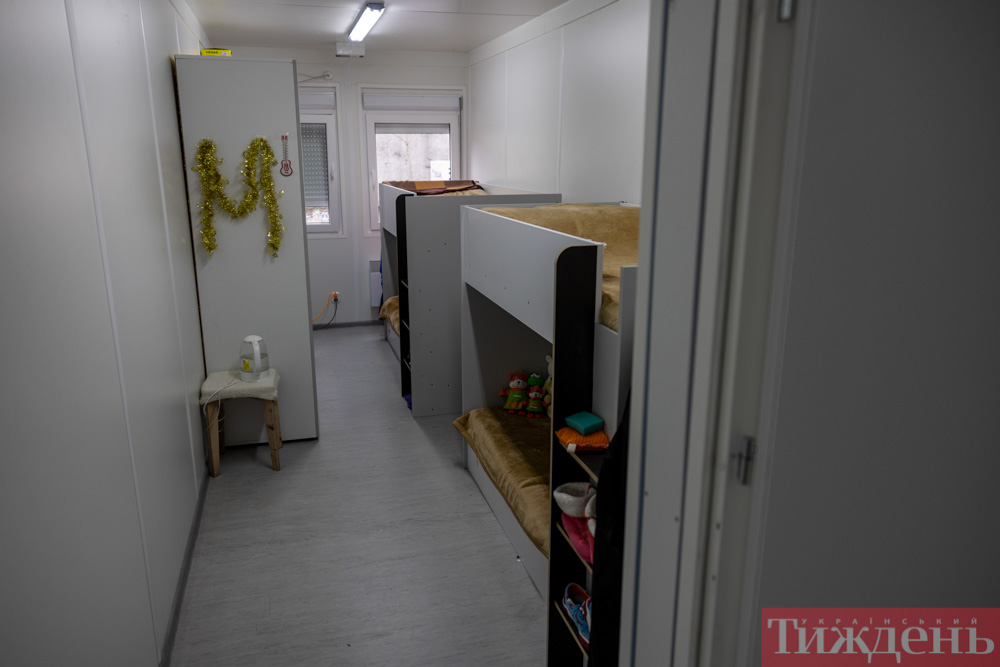
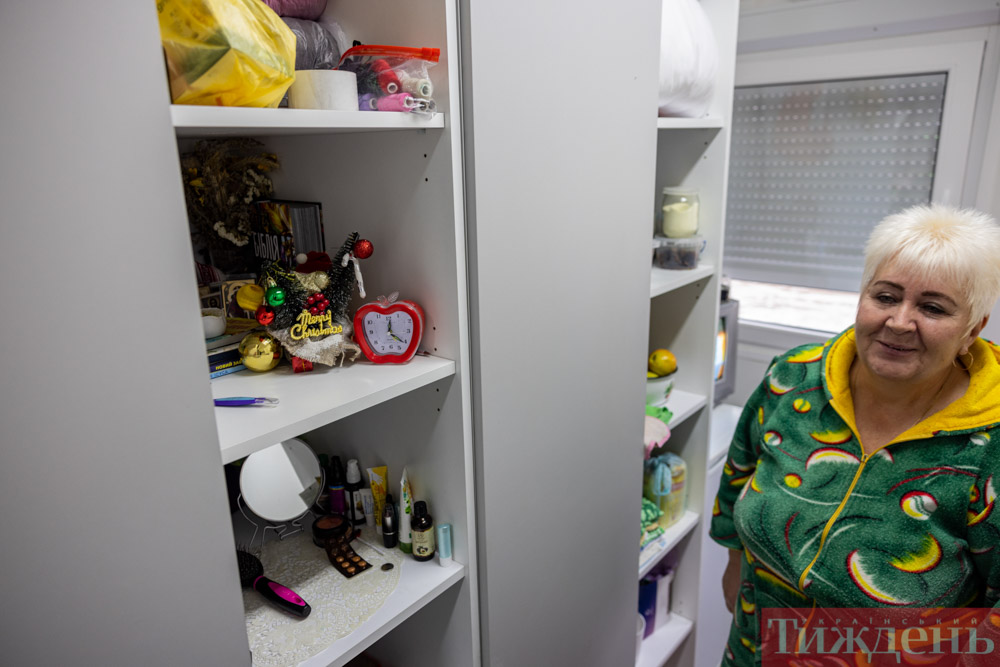
Olena and Nadya live here from almost the very beginning of the construction of the modular town. We meet them in the kitchen, where they are just finishing their lunch. Free meals is another service provided by the modular town, provided by volunteers. They bring in hot food such as soup, buckwheat with sausages and salad. Once per week, field rations are also provided to the inhabitants. Olena used to live in one of the high-rises that was destroyed. At first, the building caught fire. Her neighbor, who had two children and lived in a private house, called Olena and told her to make a run for it. As it turned out, the neighbor’s house was hit by an aerial bomb
– She died with her children. As it turned out, she saved me but died herself. I feel ill at ease because of this… – says Olena, with tears in her eyes.
When people got distracted from their painful memories, it was hard to describe the mood at the modular town as pessimistic. People found happiness in small things. Nadia even boasts that they have managed to install washing machines in every shower room. This drastically improved the situation with the queueing for laundry. Beforehand, there was only one washing machine per modular unit.
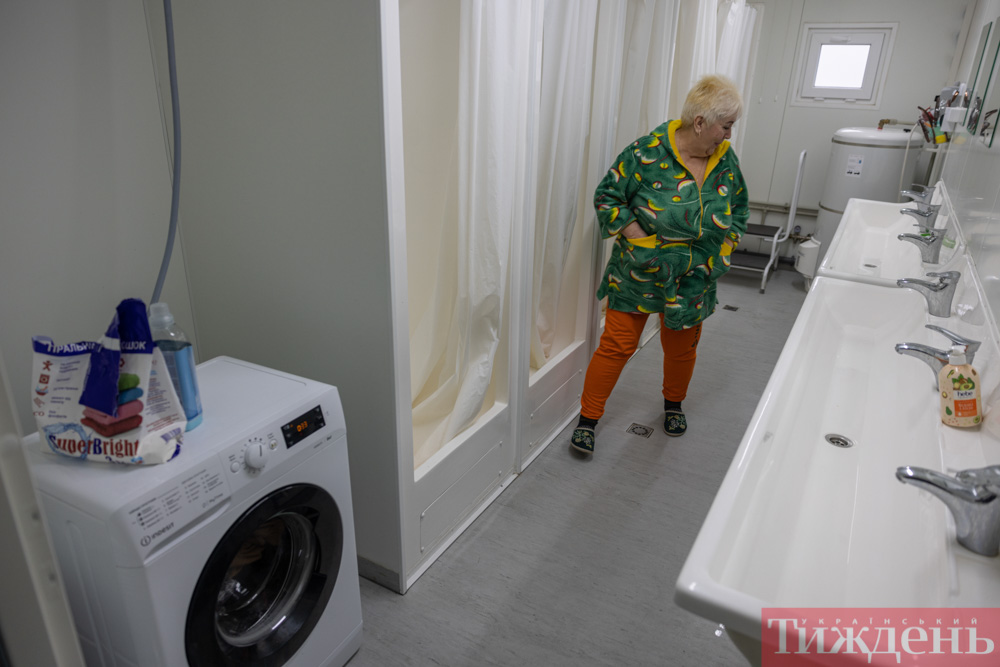
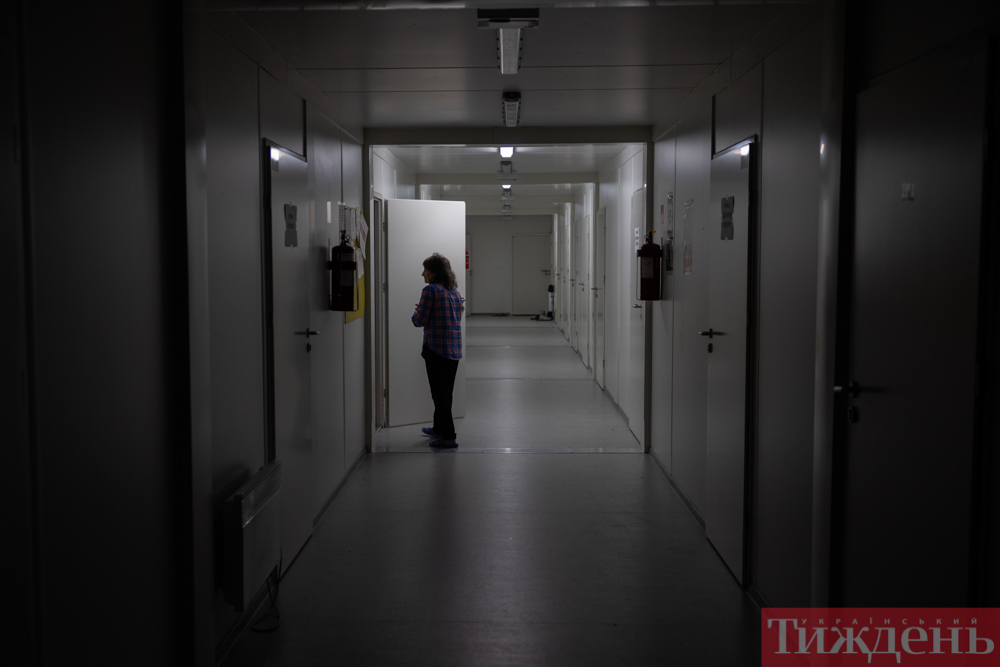
There are many problems though. After Russia started targeting Ukraine’s energy system and infrastructure, electricity cuts have been very frequent – the kitchen, water heating and the heating system have all suffered as they are dependent on it. The absence of heating in plastic buildings is felt after only a few hours: the inside becomes cold and humid very quickly. Petrol generators were used in order to try to salvage the situation, but their power was insufficient. As a result, every hour, the electric power is switched from one to the other modular unit.
– There are three generators. We thought that one would be enough for the entire module, however it was insufficient – says Yerko. – Its output power turned out to be smaller than the label stated. We measured and came to the conclusion that one modular unit consumes less than 100kW per hour. In total, there are four. As for generators, we have one that generates 250 kW per hour (enough for two units) and others that are 70kW per hour. The 70kW per hour generators can each suffice for half of a modular unit, hence the schedule with the hour-by-hour power switching between modules.
There aren’t too many sources of entertainment here. One of the units has a room with games. Foreign volunteers often provide English lessons there. In the unit that is predominantly occupied by the elderly, an improvised altar has been constructed in the living room.
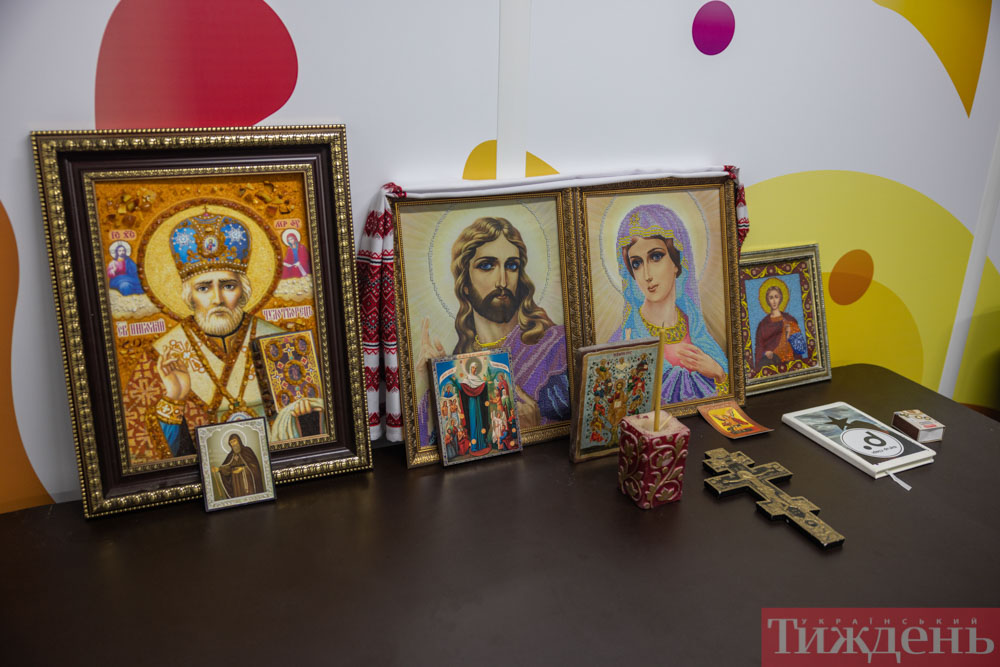
It has also been noted that the inhabitants here have been regularly visited by a priest by the name of Dmytriy. He was also present on St. Nicholas day.
– He is from our church, – says Olena, – before him, we would be going to father Viktor.
After further clarification, it becomes apparent that ‘our’ church meant the Autocephaly of the Orthodox Church of Ukraine (belonging to the Orthodox Church of Ukraine), and the one they ‘used to go to’ was the Ukrainian Orthodox Church of the Moscow Patriarchate. The women present claimed that they previously did not consider the significance of which church one or the other priest would belong to.
– Everyone was used to father Viktor. On Easter day, one could even queue from late at night, there were so many people. I can’t even really say anything bad about him as a person – says Nadia. – His apartment was also burned to the ground from the Russian bombardment. During the summer we went to his garden and asked if we could collect some apples. He allowed us. No drama. But after everything that happened… – the lady couldn’t find the words to finish her sentence and grabbed her chest with her hand, demonstrating that she no longer wanted to ever go to that church again.
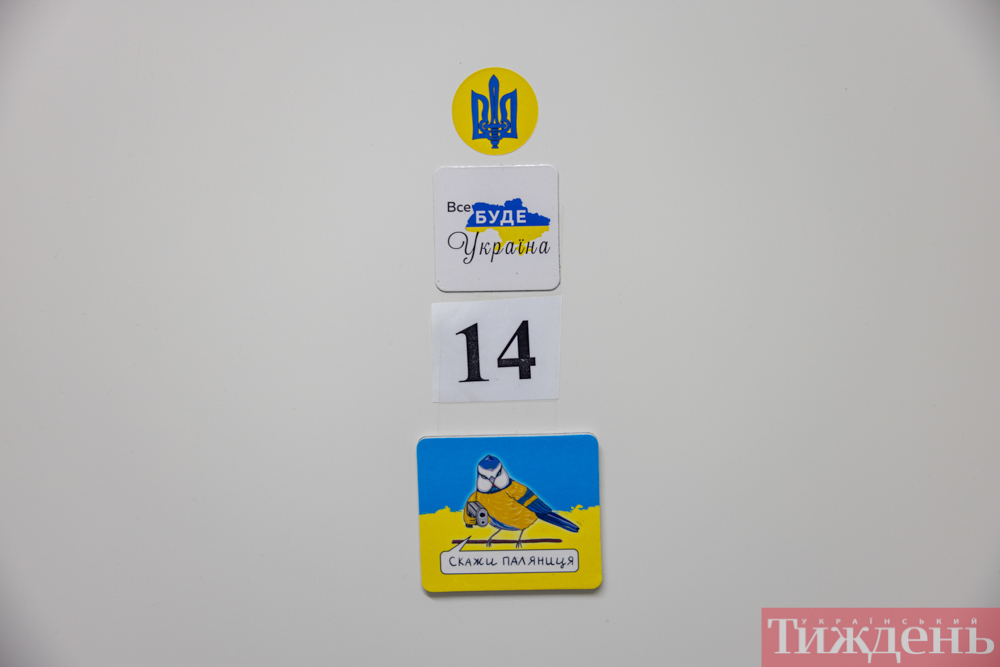
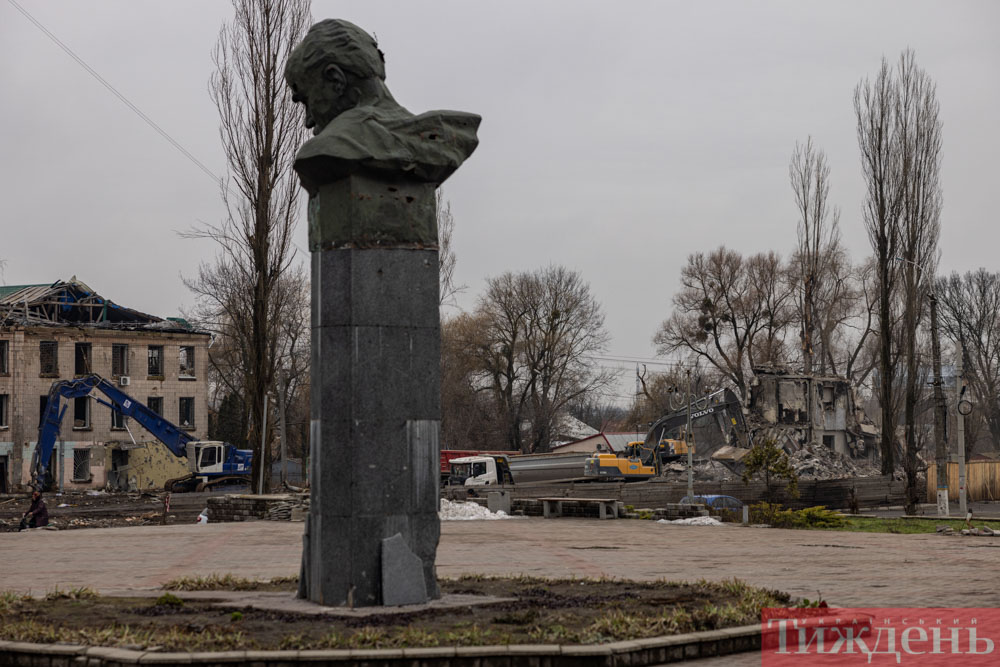
Before the war, Borodyanka had a population of about 14 thousand. Now, the population is about 8-9 thousand. Many of the questions that people have as to their future are left unanswered. In fact, no one truly can answer many of their questions – neither the government nor the locals. There are other concerns of a new invasion from Belarus. However, the locals wish to continue living here. Besides the sounds of excavators, which demolish buildings with their buckets, one can hear hammering – this is the sound of hammers that are used to repair the roofs of high-rises that survived the invasion.
